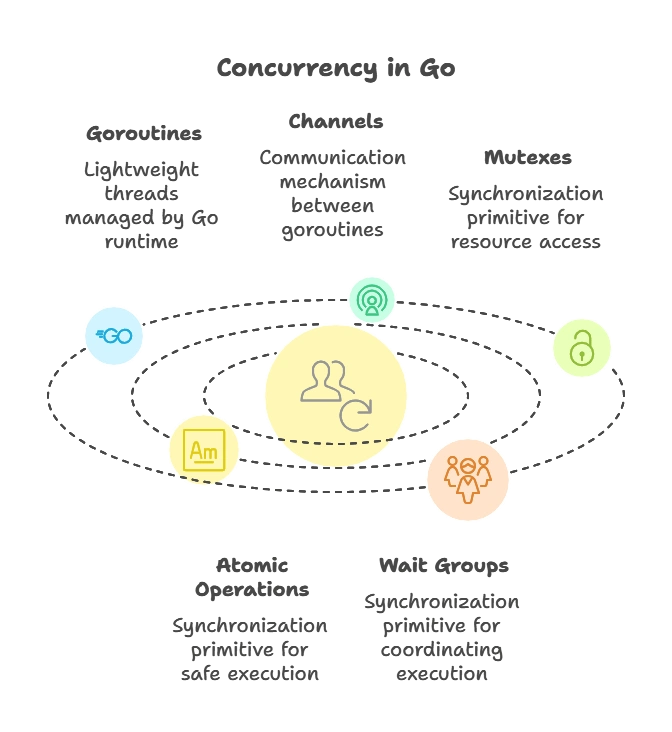Advanced Topics in Concurrency
Concurrency is a fundamental aspect of Go programming, enabling developers to write efficient and scalable applications. In this chapter, we'll explore advanced topics in concurrency, covering a wide range of concepts, techniques, and best practices to harness the full power of concurrent programming in Go.
Understanding Concurrency in Go
Basics of Goroutines and Channels
Goroutines and channels are the building blocks of concurrency in Go. We’ll review the basics of goroutines, lightweight threads managed by the Go runtime, and channels, the communication mechanism between goroutines.
Synchronization Primitives
Go provides various synchronization primitives such as mutexes, atomic operations, and wait groups to coordinate access to shared resources and ensure safe concurrent execution. Understanding these primitives is essential for writing correct concurrent programs.

Advanced Goroutine Management
Goroutine Pools
Managing a large number of goroutines efficiently requires techniques such as goroutine pools. We’ll explore how to implement and manage goroutine pools to control concurrency and resource utilization.
Contexts and Cancellation
Contexts provide a mechanism for propagating deadlines, cancellation signals, and other request-scoped values across API boundaries. We’ll discuss how to use contexts effectively to manage goroutines and handle cancellation gracefully.
func worker(ctx context.Context, jobs <-chan int, results chan<- int) {
for {
select {
case <-ctx.Done():
return // Exit gracefully on cancellation
case job := <-jobs:
// Process job...
results <- job * 2
}
}
}
This code snippet demonstrates a worker function that processes jobs from a channel until the context is canceled, ensuring graceful termination.
Channel Patterns
Fan-In and Fan-Out
Fan-in and fan-out patterns enable parallelism and concurrency by distributing work across multiple goroutines and consolidating results. We’ll explore how to implement fan-in and fan-out patterns using channels.
Select Statement and Timeout
The select statement allows goroutines to wait on multiple communication operations simultaneously, making it powerful for implementing timeouts, retries, and non-blocking operations. We’ll discuss advanced uses of the select statement in concurrent programming.
func main() {
ch1 := make(chan int)
ch2 := make(chan int)
go func() {
time.Sleep(1 * time.Second)
ch1 <- 1
}()
go func() {
time.Sleep(2 * time.Second)
ch2 <- 2
}()
select {
case <-ch1:
fmt.Println("Received from ch1")
case <-ch2:
fmt.Println("Received from ch2")
case <-time.After(3 * time.Second):
fmt.Println("Timeout")
}
}
This code snippet demonstrates the select statement with timeouts, allowing the program to wait for multiple channels with a maximum timeout duration.
Data Synchronization
Fan-In and Fan-Out Patterns:
Fan-Out:
- In the context of concurrency, “fan-out” refers to the practice of distributing work across multiple goroutines.
- This pattern is beneficial when you have a task that can be divided into independent subtasks that can execute concurrently.
- For example, if you have a large dataset to process, you can divide the dataset into smaller chunks and assign each chunk to a separate goroutine for processing.
Fan-In:
- Conversely, “fan-in” involves consolidating results from multiple goroutines into a single channel.
- After distributing work among several goroutines (fan-out), the results from these goroutines are collected or merged into a single channel.
- This consolidation step typically occurs in another goroutine dedicated to receiving and aggregating results.
- Fan-in is useful for scenarios where you need to parallelize work across multiple goroutines but want to aggregate the results into a single stream for further processing.
Select Statement and Timeout:
Select Statement:
- The select statement in Go allows a goroutine to wait on multiple communication operations simultaneously.
- It’s similar to a
switchstatement but is specifically designed for handling communication cases involving channels. - Each case inside a select statement represents a communication operation involving a channel (send or receive).
- The select statement blocks until at least one of its cases can proceed, at which point it executes that case.
- If multiple cases are ready, one of them is chosen at random.
Timeout:
- One common use of the select statement is to implement timeouts in concurrent operations.
- By including a timeout case in a select statement, you can ensure that a goroutine doesn’t wait indefinitely for a communication operation to proceed.
- If the desired operation doesn’t occur within a specified timeframe, the timeout case is triggered, allowing the goroutine to proceed with alternative actions or handle the timeout gracefully.
- Timeouts are crucial for preventing goroutines from blocking indefinitely, especially in scenarios where timely responses are essential or when dealing with potentially unresponsive channels or resources.
Advanced concurrency concepts in Go empower developers to write high-performance, scalable, and reliable concurrent programs. By mastering techniques such as goroutine management, advanced channel patterns, synchronization primitives, and data synchronization mechanisms, developers can leverage the full potential of concurrency in Go to build robust and efficient software systems. Happy coding !❤️
